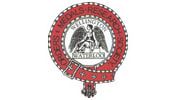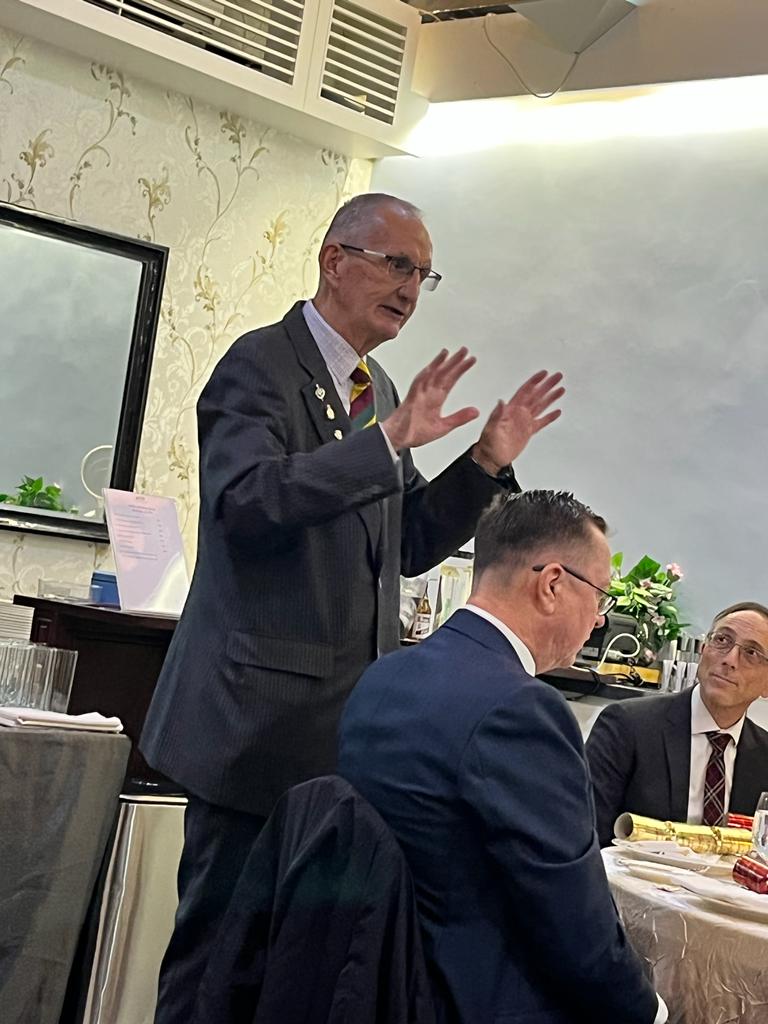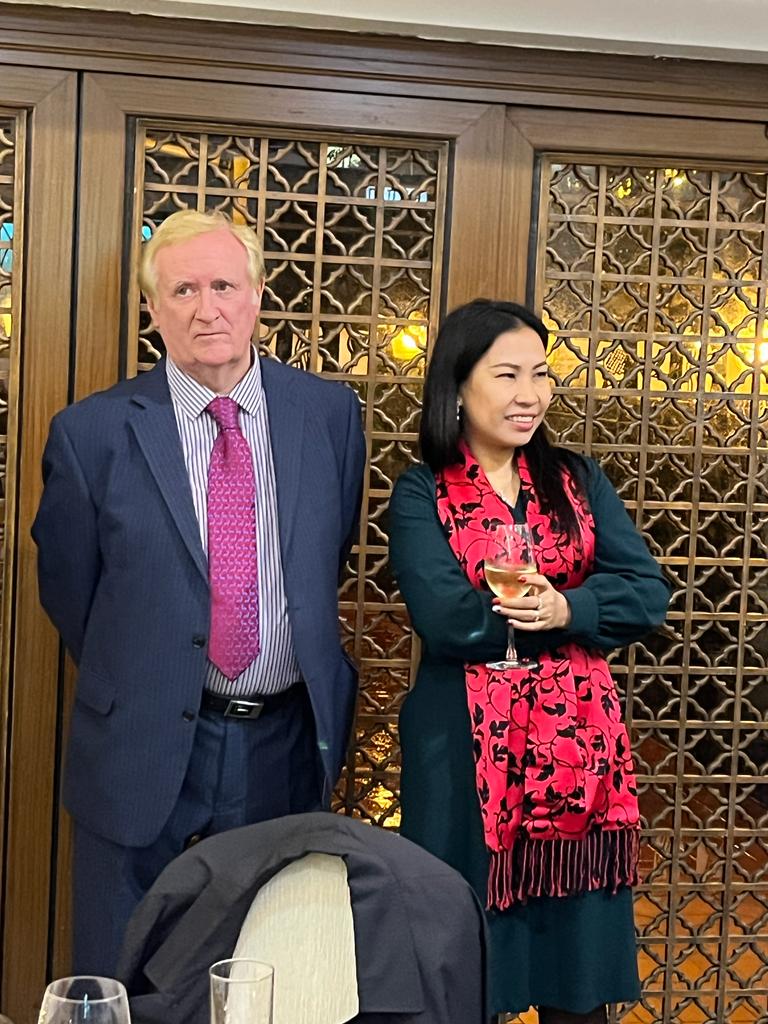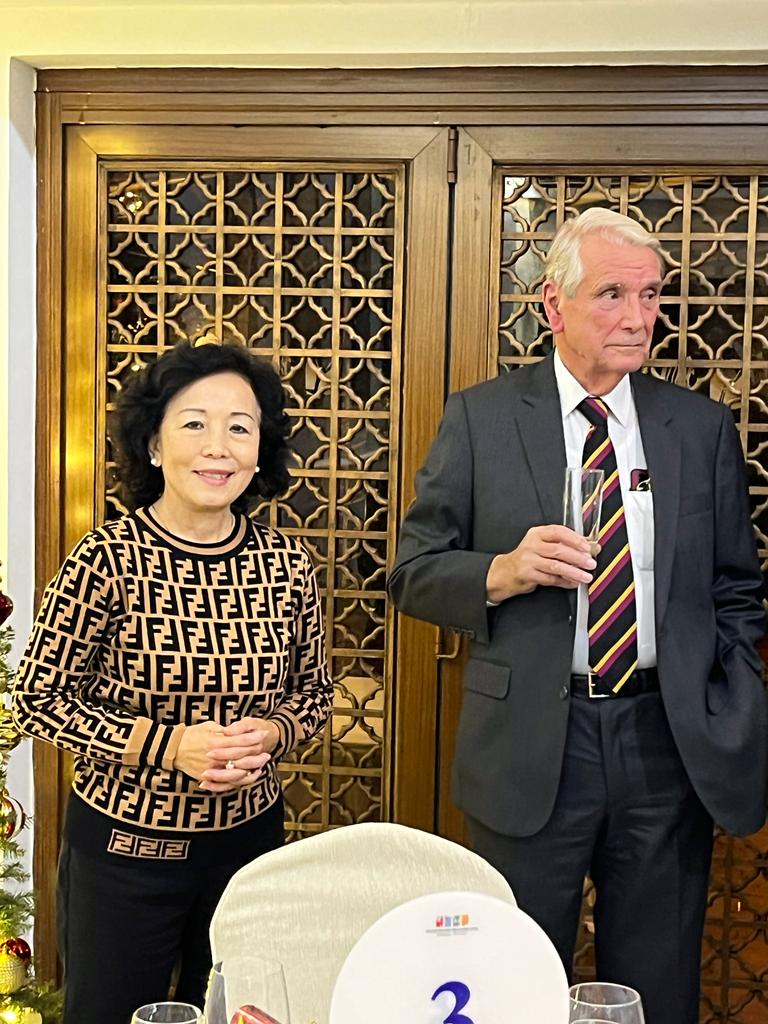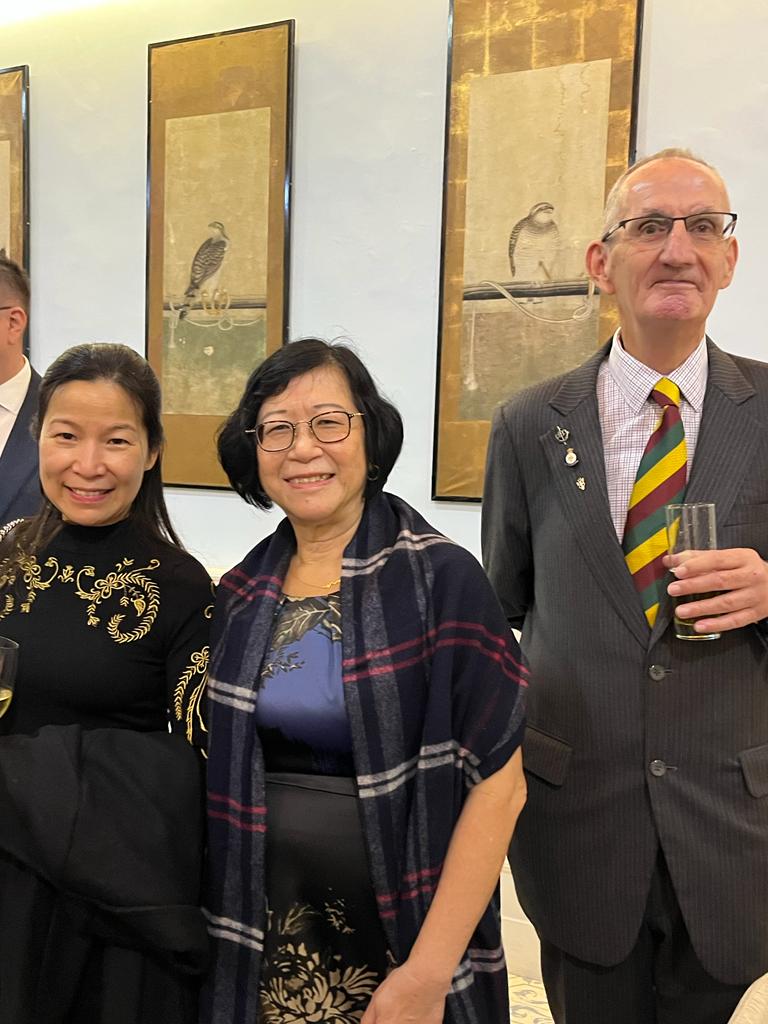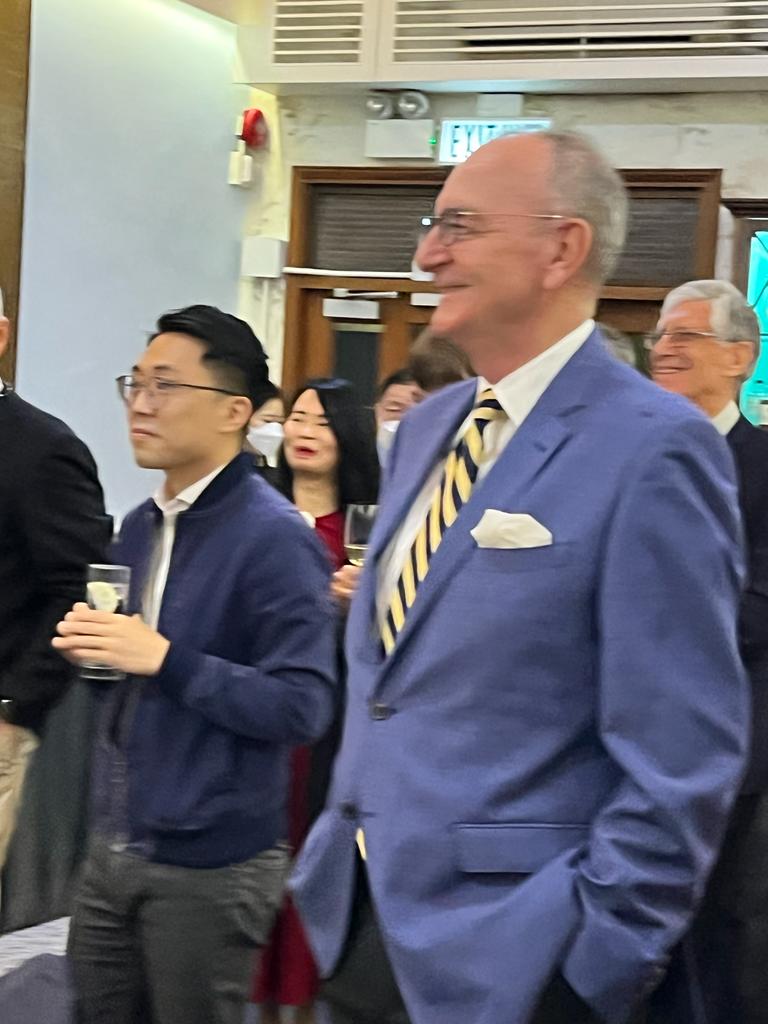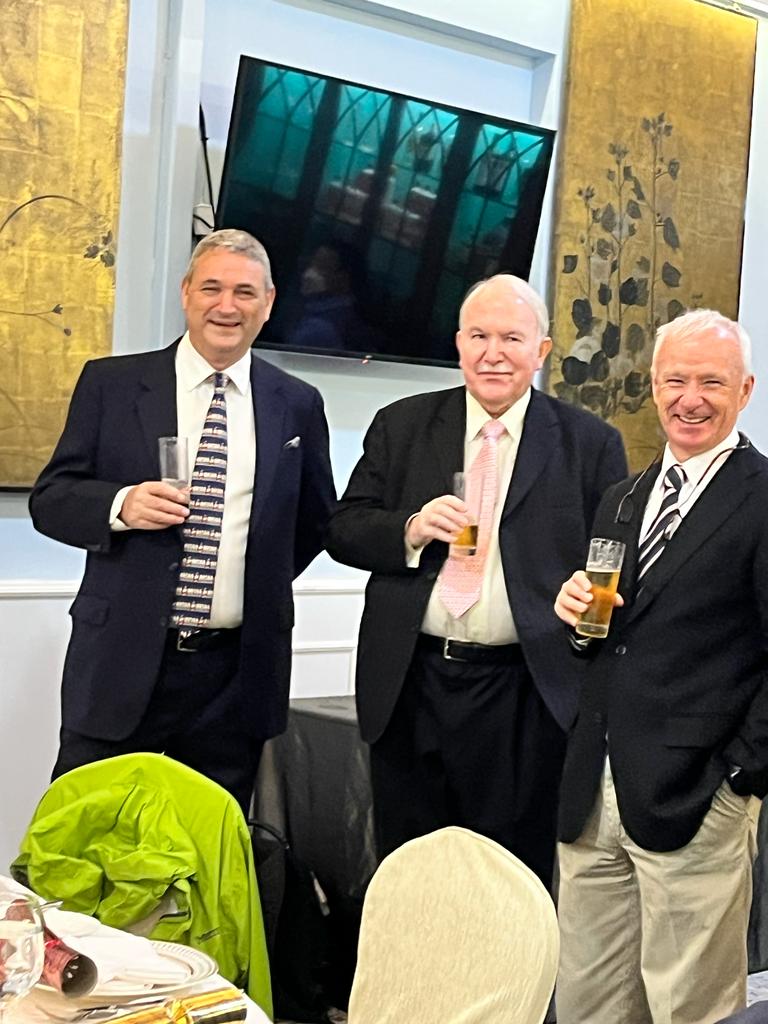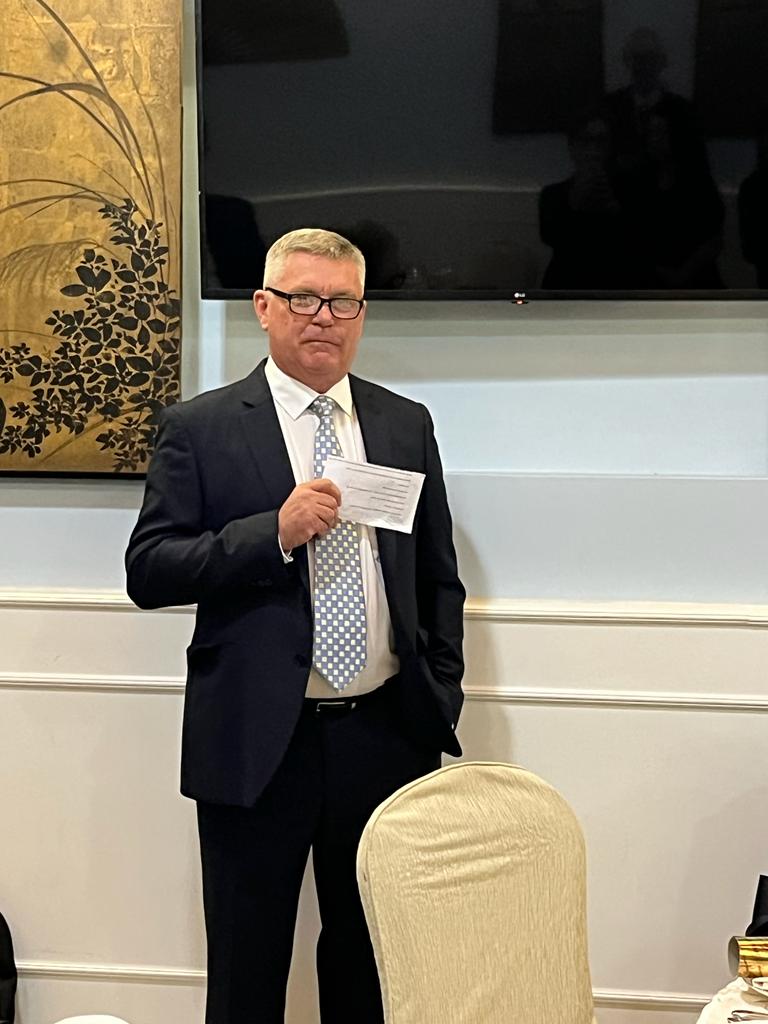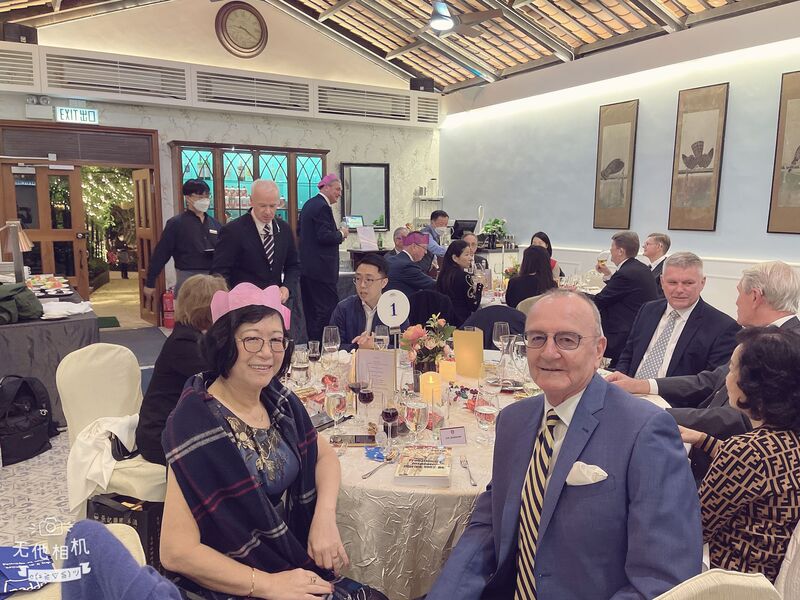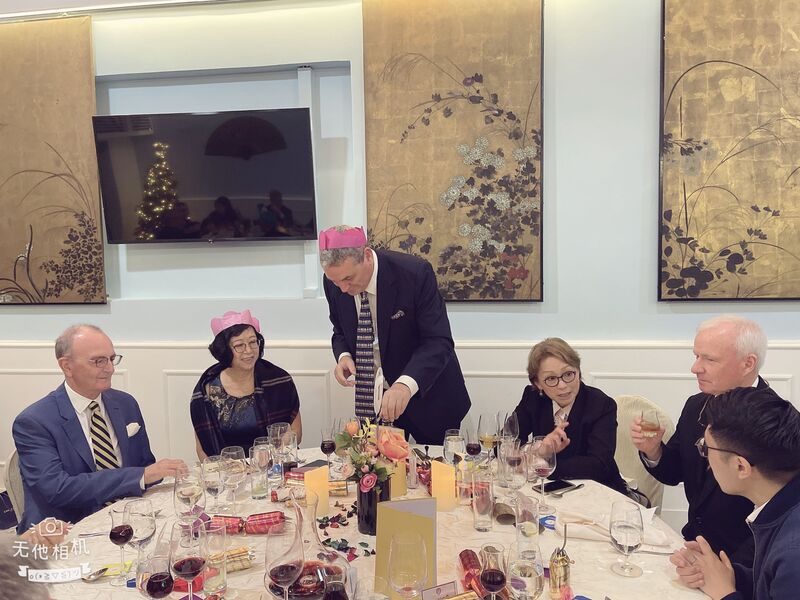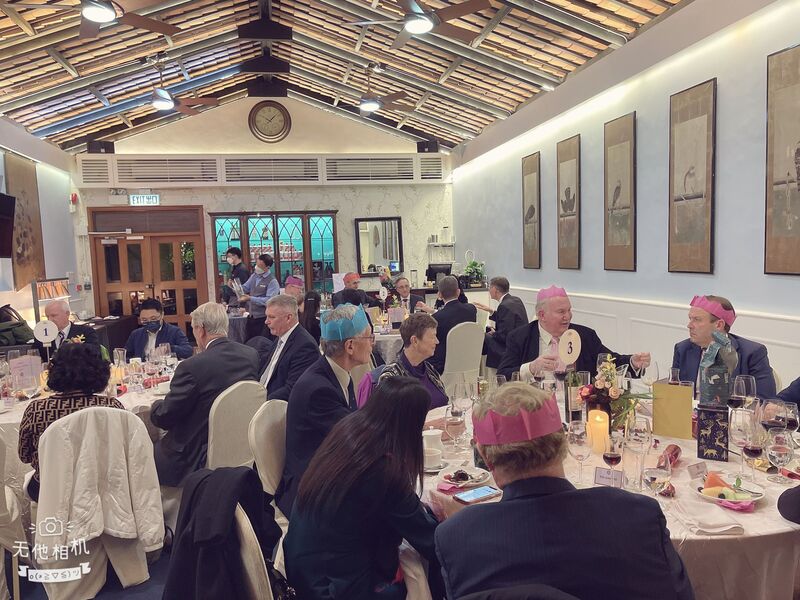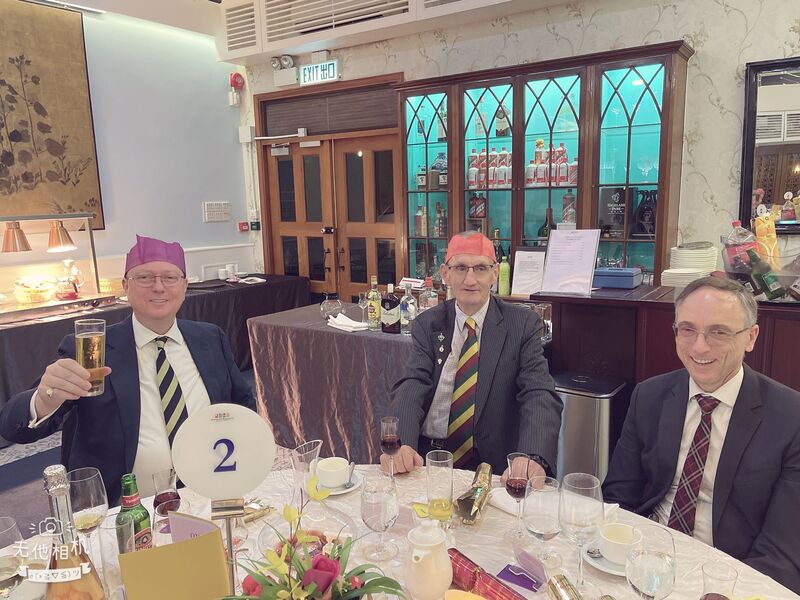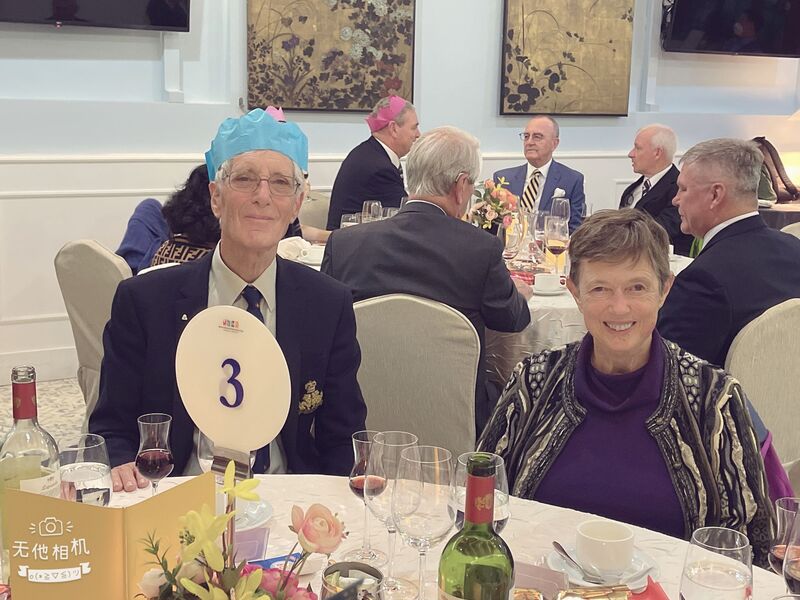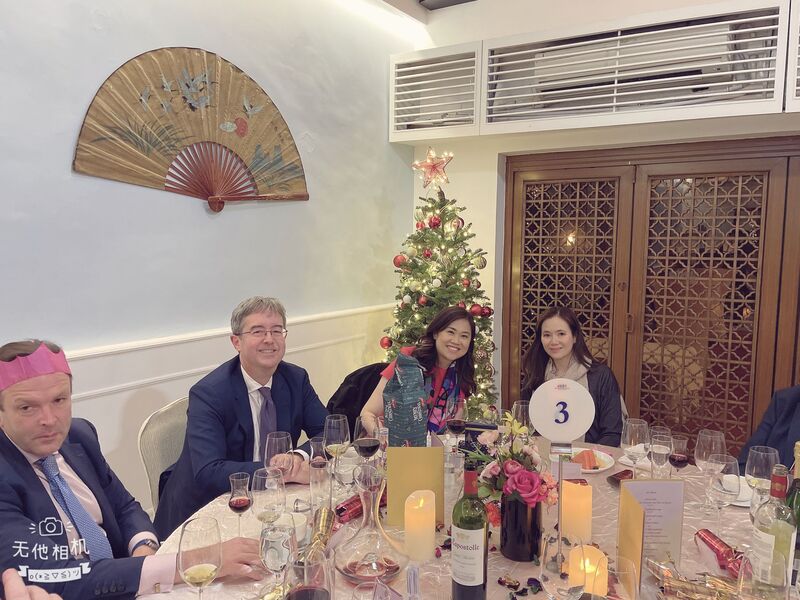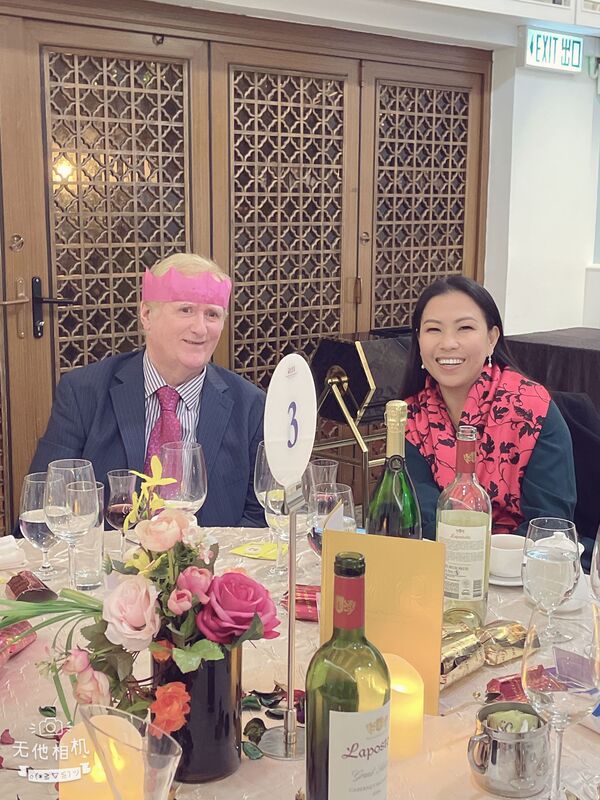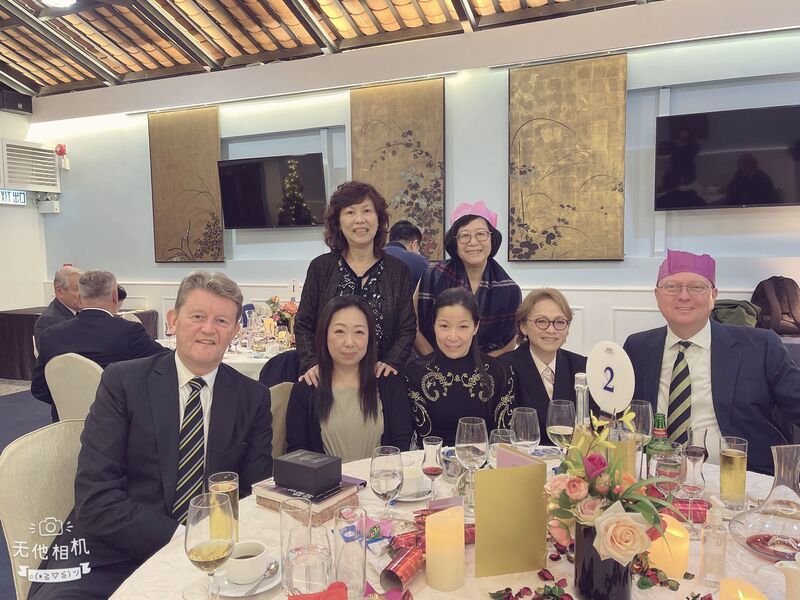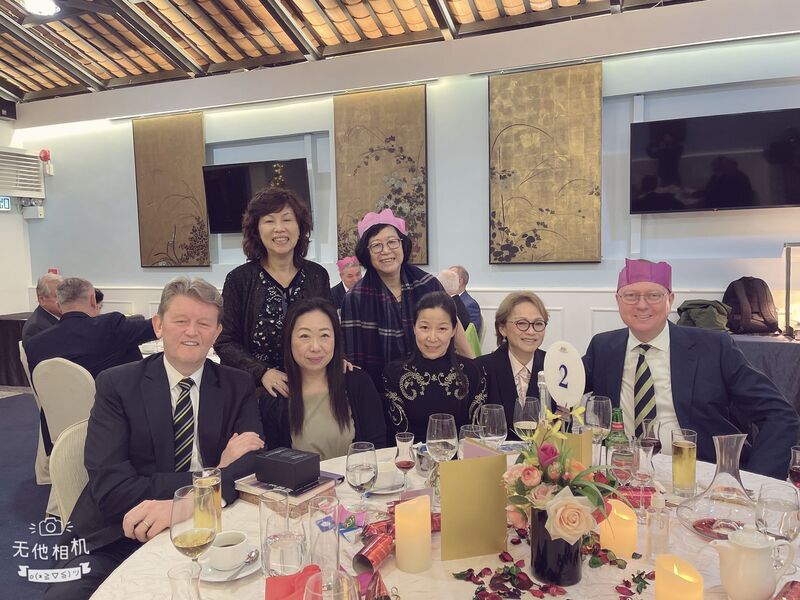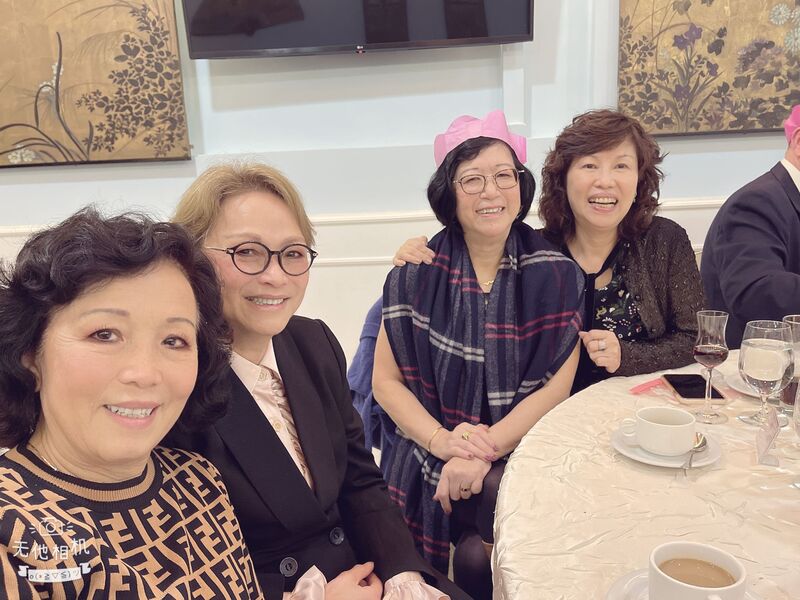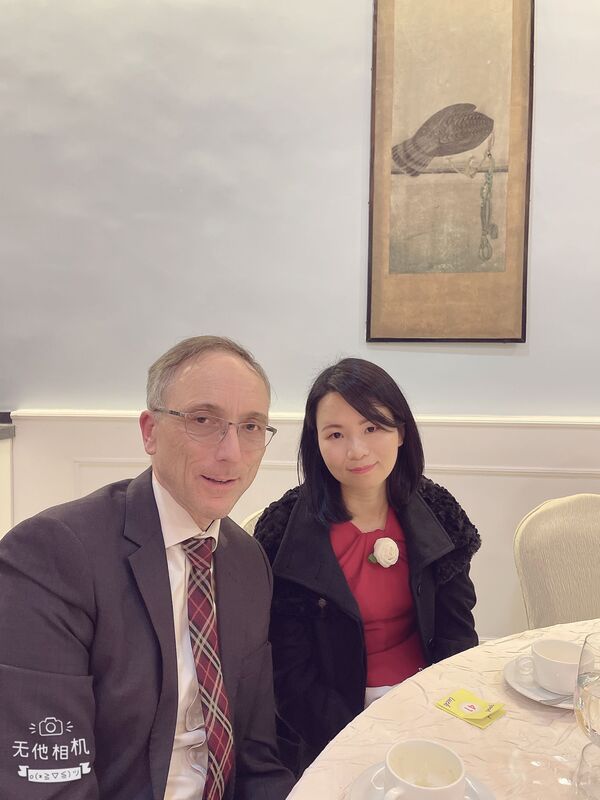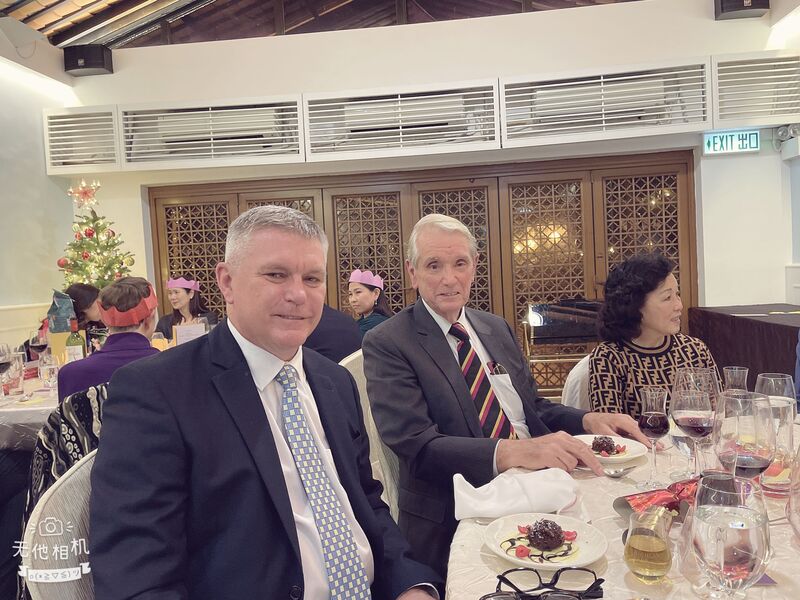Visit to Roy Delbyck
On Saturday 25 May a small group of Branch members visited the office of local lawyer Roy Delbyck, to view his amazing collection of Asian ephemera which he has collected over many years.
Roy practices U.S. customs and trade law at his own firm in Hong Kong, which he opened in 1993. His collection is housed in his office in Star House, Salisbury Road, Tsim Sha Tsui - hence the necessity to restrict the number of visitors to view his collection at any one time.
Roy has amassed a vast quantity of printed materials on Hong Kong and China, and the Chinese experience in the U.S.A., largely from the latter part of the 19th and the early 20th century.
Although primarily consisting of printed material, e.g. books, maps, photographs, journals, programmes, magazines, postcards, letters, diaries and yearbooks, Roy has also added medal groups, silver cups and presentation boxes to his collection.
His collection is a veritable Aladdin’s cave!
Having allowed visitors to view his collection for a number of years, Roy has by now perfected his arrangements governing those visits.
It is arranged in meticulous detail by subject, e.g. Hong Kong during WW2; arts and films; Nanjing and pre-war Shanghai to name but a few.
He selects a small number of artefacts from each category prior to each visit, depending upon the interests of that group. Given that we were from the OMRS, Roy had thoughtfully chosen 2 WW2 Military Medal groups from his collection, plus an 1894 Hong Kong Plague medal awarded to a British Army private, among other items for display.
Roy obtained his law degree from the University of California, Davis, and he studied Chinese at Connecticut College. He is a Council Member of the Royal Asiatic Society, Hong Kong.
Our thanks to Roy for a wonderful visit to his fascinating collection.
On Saturday 25 May a small group of Branch members visited the office of local lawyer Roy Delbyck, to view his amazing collection of Asian ephemera which he has collected over many years.
Roy practices U.S. customs and trade law at his own firm in Hong Kong, which he opened in 1993. His collection is housed in his office in Star House, Salisbury Road, Tsim Sha Tsui - hence the necessity to restrict the number of visitors to view his collection at any one time.
Roy has amassed a vast quantity of printed materials on Hong Kong and China, and the Chinese experience in the U.S.A., largely from the latter part of the 19th and the early 20th century.
Although primarily consisting of printed material, e.g. books, maps, photographs, journals, programmes, magazines, postcards, letters, diaries and yearbooks, Roy has also added medal groups, silver cups and presentation boxes to his collection.
His collection is a veritable Aladdin’s cave!
Having allowed visitors to view his collection for a number of years, Roy has by now perfected his arrangements governing those visits.
It is arranged in meticulous detail by subject, e.g. Hong Kong during WW2; arts and films; Nanjing and pre-war Shanghai to name but a few.
He selects a small number of artefacts from each category prior to each visit, depending upon the interests of that group. Given that we were from the OMRS, Roy had thoughtfully chosen 2 WW2 Military Medal groups from his collection, plus an 1894 Hong Kong Plague medal awarded to a British Army private, among other items for display.
Roy obtained his law degree from the University of California, Davis, and he studied Chinese at Connecticut College. He is a Council Member of the Royal Asiatic Society, Hong Kong.
Our thanks to Roy for a wonderful visit to his fascinating collection.
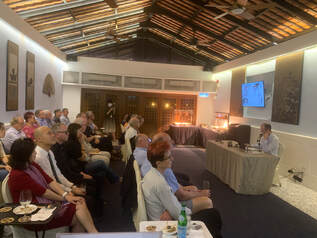
Say cheese! Using old photos from British servicemen’s albums to explore Hong Kong’s military past.
On Tuesday 26 March a large group of Branch members gathered at the United Services Recreation Club (USRC) in Jordan, to listen to a presentation by historian David Bellis. The audience was augmented by members of the USRC.
David runs the award-winning gwulo.com website, home to over 50,000 pages on Hong Kong history, including over 35,000 photographs.
During his talk, David explored Hong Kong’s military history using old photos from albums which belonged to British servicemen stationed in the territory long ago. These photos have been scanned at high resolution, enabling David to zoom in to show us their hidden details. He was then able to piece together the story behind each scene.
His talk was richly illustrated, using photos from many sources including his own collection hitherto not shown, as well as the gwulo website. Some showed locations which have long disappeared from Hong Kong, e.g. Mt. Austin barracks and Kowloon City; others of places still extant, e.g. the Cenotaph and A.R.P. tunnels on Hong Kong island. The Royal Navy was represented by a submarine flotilla in dry dock!
This talk was different to the ones David usually gives, in that in deference to his audience (OMRS) he concentrated on a military connection.
At the conclusion of his presentation, David was presented with an OMRS shield in appreciation of all his efforts.
As always, our heartfelt thanks to the Club General Manager for not only making the delightful USRC facility available to the Branch, but also for arranging the provision of excellent refreshments and a cash bar.
On Tuesday 26 March a large group of Branch members gathered at the United Services Recreation Club (USRC) in Jordan, to listen to a presentation by historian David Bellis. The audience was augmented by members of the USRC.
David runs the award-winning gwulo.com website, home to over 50,000 pages on Hong Kong history, including over 35,000 photographs.
During his talk, David explored Hong Kong’s military history using old photos from albums which belonged to British servicemen stationed in the territory long ago. These photos have been scanned at high resolution, enabling David to zoom in to show us their hidden details. He was then able to piece together the story behind each scene.
His talk was richly illustrated, using photos from many sources including his own collection hitherto not shown, as well as the gwulo website. Some showed locations which have long disappeared from Hong Kong, e.g. Mt. Austin barracks and Kowloon City; others of places still extant, e.g. the Cenotaph and A.R.P. tunnels on Hong Kong island. The Royal Navy was represented by a submarine flotilla in dry dock!
This talk was different to the ones David usually gives, in that in deference to his audience (OMRS) he concentrated on a military connection.
At the conclusion of his presentation, David was presented with an OMRS shield in appreciation of all his efforts.
As always, our heartfelt thanks to the Club General Manager for not only making the delightful USRC facility available to the Branch, but also for arranging the provision of excellent refreshments and a cash bar.
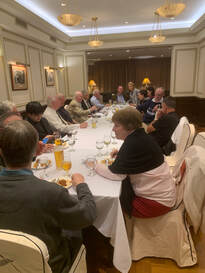
Branch Annual General Meeting 2024 and Visit to Zetland Hall
On Saturday 17 February 2024, an excellent turnout of close to 20 Branch members attended the Branch AGM in addition to enjoying a visit to the home of Freemasonry in Hong Kong, Zetland Hall.
During the course of our visit attendees were privileged to visit the Robing Room and the Temple, in addition to viewing a large number of artefacts connected with the Craft, before adjourning for the formal part of the evening - the Branch AGM.
Following the latter, a convivial time was spent in the bar where refreshments were made available. Our heartfelt thanks to Branch stalwart and former President Angus Stevenson-Hamilton, who facilitated our visit and hosted us throughout the evening.
Formal Minutes of the meeting will be uploaded to this website in due course.
On Saturday 17 February 2024, an excellent turnout of close to 20 Branch members attended the Branch AGM in addition to enjoying a visit to the home of Freemasonry in Hong Kong, Zetland Hall.
During the course of our visit attendees were privileged to visit the Robing Room and the Temple, in addition to viewing a large number of artefacts connected with the Craft, before adjourning for the formal part of the evening - the Branch AGM.
Following the latter, a convivial time was spent in the bar where refreshments were made available. Our heartfelt thanks to Branch stalwart and former President Angus Stevenson-Hamilton, who facilitated our visit and hosted us throughout the evening.
Formal Minutes of the meeting will be uploaded to this website in due course.
Annual Christmas Dinner
On Thursday 14 December 2023, a good turnout of 24 Branch members and guests sat down to a sumptuous Christmas Dinner at the United Services Recreation Club in Kowloon.
The events of the evening followed the successful format of previous years, with pre-dinner drinks on the clubhouse verandah before moving inside. As one long-standing Branch member later observed; “it was good to see both well-known faces and many new ones (present).”
In addition to the traditional Christmas fare, attendees also enjoyed our popular lucky draw which raised over $2000-HK for Branch funds.
On Thursday 14 December 2023, a good turnout of 24 Branch members and guests sat down to a sumptuous Christmas Dinner at the United Services Recreation Club in Kowloon.
The events of the evening followed the successful format of previous years, with pre-dinner drinks on the clubhouse verandah before moving inside. As one long-standing Branch member later observed; “it was good to see both well-known faces and many new ones (present).”
In addition to the traditional Christmas fare, attendees also enjoyed our popular lucky draw which raised over $2000-HK for Branch funds.
Visit to The Royal Hong Kong Regiment (Volunteers) Association Clubhouse in Happy Valley
The Royal Hong Kong Regiment (Volunteers) Association Clubhouse in Happy Valley the scene of a recent Branch meeting on Thursday 23 November 2023. A good turnout of members and friends came together to hear Branch stalwart Ron Taylor, a retired Major in the Regiment, give a very interesting presentation. Following a talk on the history of the Regiment, which dates back to the 1850s when it was raised to provide protection for the then Colony when regular troops departed for the Crimea, Ron showed us a number of artefacts which are held by the Regiment and are on display in the Clubhouse.
Many of these items date back to the earliest days of the Regiment’s inception.The attendees, which included Patricia O’Sullivan in from the UK and Dan FitzGerald in from Bangkok, also heard a short talk on one of the most famous members of the Regiment, Major (later Colonel) Evan Stewart, who commanded No. 3 (Machine Gun) Company with distinction and gallantry during the 1941 conflict. Finally Branch President Steve Verralls exhibited what was thought to be a Chinese export silver hand mirror which had been presented to a Capt Rodgers, RE by the Taikoo Section of the Engineer Company of the Hong Kong Volunteers in 1917. After some discussion, and thanks to Patricia O’Sullivan, it was believed that the mirror is in fact a sliver presentation version of a form of engineering inspection mirror.
Our thanks to Ron Taylor for facilitating a most enjoyable evening for the Branch and to those who attended.
The Royal Hong Kong Regiment (Volunteers) Association Clubhouse in Happy Valley the scene of a recent Branch meeting on Thursday 23 November 2023. A good turnout of members and friends came together to hear Branch stalwart Ron Taylor, a retired Major in the Regiment, give a very interesting presentation. Following a talk on the history of the Regiment, which dates back to the 1850s when it was raised to provide protection for the then Colony when regular troops departed for the Crimea, Ron showed us a number of artefacts which are held by the Regiment and are on display in the Clubhouse.
Many of these items date back to the earliest days of the Regiment’s inception.The attendees, which included Patricia O’Sullivan in from the UK and Dan FitzGerald in from Bangkok, also heard a short talk on one of the most famous members of the Regiment, Major (later Colonel) Evan Stewart, who commanded No. 3 (Machine Gun) Company with distinction and gallantry during the 1941 conflict. Finally Branch President Steve Verralls exhibited what was thought to be a Chinese export silver hand mirror which had been presented to a Capt Rodgers, RE by the Taikoo Section of the Engineer Company of the Hong Kong Volunteers in 1917. After some discussion, and thanks to Patricia O’Sullivan, it was believed that the mirror is in fact a sliver presentation version of a form of engineering inspection mirror.
Our thanks to Ron Taylor for facilitating a most enjoyable evening for the Branch and to those who attended.
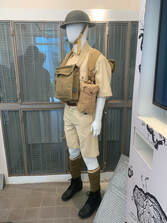
Visit to Hong Kong Jockey Club (HKJC) University of Chicago Heritage Courtyard and Interpretation Centre
On Saturday 23 September 2023, a group of members and guests enjoyed a visit in glorious sunshine to a location which I believe was a first for the Branch. The location was the Hong Kong Jockey Club (HKJC) University of Chicago Heritage Courtyard and Interpretation Centre. (Quite a mouthful, I know)! The site was originally part of the Jubilee Gun Battery at Mt. Davis, which in turn formed part of Hong Kong’s western coastal defence system. After WW 2 part of the complex, which had been constructed in the 1930’s, was used as makeshift accommodation for refugees before being converted to the Officers Mess for the British Army’s Royal Engineers. In 1961 it became the Victoria Road Detention Centre, operated by the Hong Kong Police’s Special Branch to imprison activists involved in the 1967 left-wing inspired riots which ravaged the Colony. It was later used by the Police for training purposes and the Witness Protection Unit. The site was unoccupied for many years, although it was apparently used as a film location! In 2013 it became the campus of the University of Chicago in Hong Kong, and has been tastefully restored thanks to the generous support of the HKJC Charities Trust and other individuals. The tour incorporated the site described above in addition to the restored No. 2 gun position, part of 3 such positions which comprised the Jubilee Battery. We opted for a docent-led tour which allowed us access to parts of the Centre not normally open to the public. Our thanks to Ms. Lillian Lau and the staff of the Centre for ensuring we enjoyed an excellent visit to a fascinating piece of Hong Kong heritage.
On Saturday 23 September 2023, a group of members and guests enjoyed a visit in glorious sunshine to a location which I believe was a first for the Branch. The location was the Hong Kong Jockey Club (HKJC) University of Chicago Heritage Courtyard and Interpretation Centre. (Quite a mouthful, I know)! The site was originally part of the Jubilee Gun Battery at Mt. Davis, which in turn formed part of Hong Kong’s western coastal defence system. After WW 2 part of the complex, which had been constructed in the 1930’s, was used as makeshift accommodation for refugees before being converted to the Officers Mess for the British Army’s Royal Engineers. In 1961 it became the Victoria Road Detention Centre, operated by the Hong Kong Police’s Special Branch to imprison activists involved in the 1967 left-wing inspired riots which ravaged the Colony. It was later used by the Police for training purposes and the Witness Protection Unit. The site was unoccupied for many years, although it was apparently used as a film location! In 2013 it became the campus of the University of Chicago in Hong Kong, and has been tastefully restored thanks to the generous support of the HKJC Charities Trust and other individuals. The tour incorporated the site described above in addition to the restored No. 2 gun position, part of 3 such positions which comprised the Jubilee Battery. We opted for a docent-led tour which allowed us access to parts of the Centre not normally open to the public. Our thanks to Ms. Lillian Lau and the staff of the Centre for ensuring we enjoyed an excellent visit to a fascinating piece of Hong Kong heritage.
Branch Social Evening
A bit of a get-together and a few drinks we had in Churchills on 21st July too cool the summer heat.
A bit of a get-together and a few drinks we had in Churchills on 21st July too cool the summer heat.
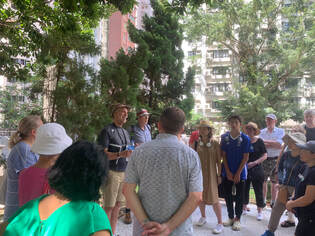
Visit to the Jewish Cemetery Sunday 4 June 2023
Just under 40 Branch members and guests braved the scorching heat to join a visit to the Jewish Cemetery in Happy Valley. We were privileged to have cemetery custodian Howard Elias as our guide for the afternoon.
The development of Hong Kong island after its cession to the British in 1842 saw a pressing need for a cemetery for the growing Jewish population, particularly following an influx of traders from Iraq and India. Accordingly negotiations for the purchase of a plot of what had hitherto been farmland were conducted with the British Crown, and in 1855 the site was opened as a burial ground by members of the prominent Sassoon family. The cemetery was expanded in 1904 by the acquisition of an adjoining piece of land.
The cemetery is laid out on five levels, and occupies a very scenic and tranquil spot amid the high rise buildings of the urban jungle which surrounds it.
The first burial took place in 1857. The majority of burials in the early years were of single men, as it was felt to be imprudent to bring wives and families to the plague-ridden and often dangerous Colony! As the Jewish community prospered, the simple granite sarcophagi that characterise most of the early burials gave way to more ornate markers and tombs.
During the course of our visit, Howard recounted the histories of some of the leading Jewish families who have settled in Hong Kong since the earliest days of British occupation, including members of the Sassoon, Belilios, Kadoorie and Odell families.
Our visit concluded with a short presentation on Jewish funerary rites and a visit to the chapel and tahara (ritual purity) room. Our thanks to Howard for a most informative and entertaining visit to a little-known gem in Hong Kong.
Just under 40 Branch members and guests braved the scorching heat to join a visit to the Jewish Cemetery in Happy Valley. We were privileged to have cemetery custodian Howard Elias as our guide for the afternoon.
The development of Hong Kong island after its cession to the British in 1842 saw a pressing need for a cemetery for the growing Jewish population, particularly following an influx of traders from Iraq and India. Accordingly negotiations for the purchase of a plot of what had hitherto been farmland were conducted with the British Crown, and in 1855 the site was opened as a burial ground by members of the prominent Sassoon family. The cemetery was expanded in 1904 by the acquisition of an adjoining piece of land.
The cemetery is laid out on five levels, and occupies a very scenic and tranquil spot amid the high rise buildings of the urban jungle which surrounds it.
The first burial took place in 1857. The majority of burials in the early years were of single men, as it was felt to be imprudent to bring wives and families to the plague-ridden and often dangerous Colony! As the Jewish community prospered, the simple granite sarcophagi that characterise most of the early burials gave way to more ornate markers and tombs.
During the course of our visit, Howard recounted the histories of some of the leading Jewish families who have settled in Hong Kong since the earliest days of British occupation, including members of the Sassoon, Belilios, Kadoorie and Odell families.
Our visit concluded with a short presentation on Jewish funerary rites and a visit to the chapel and tahara (ritual purity) room. Our thanks to Howard for a most informative and entertaining visit to a little-known gem in Hong Kong.
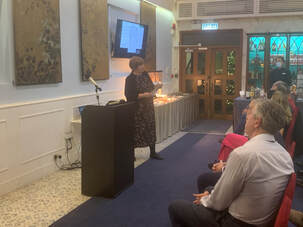
Hong Kong’s 500 : Life, Death and Gallantry in the Trenches of World War 1 - Patricia O’Sullivan - 1st February 2023
The rush of enthusiasm to enlist in the Armed Forces by many young men in Britain during the summer of 1914 had its counterpart in Hong Kong, but the demands of business and administration had first to be met. Yet over the course of the conflict, some 10% of the British male population of the Colony did enlist. Of these 500 men, 140 were in Government service; the Police Force sending the largest contingent. In total, about 14% (70 men) lost their lives in the conflict. During her talk, Patricia O’Sullivan told the stories of some of these men, a few of whom were born either in Hong Kong or Macau. At least two of the erstwhile Police officers, Charles Wilson and Alfred Hutchins, were awarded gallantry medals; the M.M. and M.C. respectively. One man had been a journalist with the Hong Kong Daily Press and put his reporting skills to good use by providing readers in the Colony with tales of life at the from the front.A good turnout at the USRC enjoyed a fascinating talk followed by good food and drink. The opportunity was taken to present club GM Noel Burns with a OMRS plaque in appreciation of the support the club has given to the Branch. Many thanks to Patricia and Noel for a fine evening.
The rush of enthusiasm to enlist in the Armed Forces by many young men in Britain during the summer of 1914 had its counterpart in Hong Kong, but the demands of business and administration had first to be met. Yet over the course of the conflict, some 10% of the British male population of the Colony did enlist. Of these 500 men, 140 were in Government service; the Police Force sending the largest contingent. In total, about 14% (70 men) lost their lives in the conflict. During her talk, Patricia O’Sullivan told the stories of some of these men, a few of whom were born either in Hong Kong or Macau. At least two of the erstwhile Police officers, Charles Wilson and Alfred Hutchins, were awarded gallantry medals; the M.M. and M.C. respectively. One man had been a journalist with the Hong Kong Daily Press and put his reporting skills to good use by providing readers in the Colony with tales of life at the from the front.A good turnout at the USRC enjoyed a fascinating talk followed by good food and drink. The opportunity was taken to present club GM Noel Burns with a OMRS plaque in appreciation of the support the club has given to the Branch. Many thanks to Patricia and Noel for a fine evening.
Museum of Coastal Defence Visit - 14th January 2023
The Museum of Coastal Defence (MCD) is Hong Kong’s only museum dedicated to military history. Located in a former British Army fort overlooking the Lei Yue Mun channel in the north-east of HK island, the site now occupied by the museum was chosen by the British military authorities in 1887 for the construction of defences to the eastern approaches to Victoria harbour. The fort was the scene of bitter fighting during the battle for Hong Kong and was practically in the middle of the Japanese invasion point of the island on the night of 18 December 1941. Following the departure of the British military from the facility in 1987, it was decided (in 1993) that the fort would be converted to a museum and it opened as such to the public in July 2000. In 2018 the MCD was closed for renovation and after a hiatus of over four years, reopened late last month. We were honoured to have one of the driving forces behind this renovation, Dr. Kwong Chi Man, as our guide for this visit which was well attended and a very enjoyable afternoon.
The Museum of Coastal Defence (MCD) is Hong Kong’s only museum dedicated to military history. Located in a former British Army fort overlooking the Lei Yue Mun channel in the north-east of HK island, the site now occupied by the museum was chosen by the British military authorities in 1887 for the construction of defences to the eastern approaches to Victoria harbour. The fort was the scene of bitter fighting during the battle for Hong Kong and was practically in the middle of the Japanese invasion point of the island on the night of 18 December 1941. Following the departure of the British military from the facility in 1987, it was decided (in 1993) that the fort would be converted to a museum and it opened as such to the public in July 2000. In 2018 the MCD was closed for renovation and after a hiatus of over four years, reopened late last month. We were honoured to have one of the driving forces behind this renovation, Dr. Kwong Chi Man, as our guide for this visit which was well attended and a very enjoyable afternoon.
Branch Christmas Dinner 13th December 2022 - For a second year running the Branch Christmas Dinner was held at the United Services Recreation Club in Jordan with 28 members and guests sitting down for dinner. A traditional Christmas Banquet was served and the lucky draw raised $2000 for branch funds. A fine night was had by all, images of which can be seen below:
Project Avenger Presentation by Craig Mitchell 20th July 2022 - In 2012 local resident and military historian Craig Mitchell, whilst hiking the hills on HK island, stumbled upon the wreckage of a wartime U.S. Navy plane. Upon investigation, the aircraft was found to be from a U.S. Navy Task Force consisting of no fewer than 10 aircraft carriers engaged in a bombing mission of Japanese-occupied HK on 16 January 1945. This amazing discovery kick-started what became known as “Project Avenger.” Craig initiated a 10-year campaign for funding to research the crash site in Tai Tam; negotiating with the relevant authorities, (including the U.S. Navy’s Heritage Command), and obtaining the required local permits and licences.

Visit to Sai Wan Military Cemetery 27th November 2021
After a hiatus of close to 18 months due to the imposition of COVID restrictions, the Branch has finally been able to resume activities. December 2021 will commemorate the 80th anniversary of the outbreak of the Pacific War, and it seemed therefore appropriate to conduct a visit to a venue closely linked to this campaign. On Saturday 27 November 2021 a large group of members and friends visited the Sai Wan Memorial and War Cemetery on Hong Kong island. The cemetery is the final resting place of some 1500 men killed during the 1941 Battle for Hong Kong, plus a large number who died elsewhere in Asia but who were reinterred in Sai Wan when it opened in 1946. More than 2000 Commonwealth soldiers who were killed during this conflict but who have no known grave are commemorated on a memorial panel near the entrance to the cemetery. During our visit, members recounted the acts of gallantry displayed by two men during the battle who are commemorated there. The first was the Canadian W.O. 2 John Osborn who was posthumously awarded the Victoria Cross; the other was Lance Bombardier John Bullen of the Royal Artillery who was killed in action at Stanley. Although recommended for the Victoria Cross, he eventually received a Mention in Despatches. The group went on to visit a number of notable graves in the cemetery. These included that of the most senior officer killed during the battle, Brigadier John Lawson, the commander of the Canadian force which arrived in November to augment the garrison. Perhaps surprisingly the cemetery is also the resting place of two British Major Generals. One of these officers died of illness as a PoW in Formosa (Taiwan), the other in a plane crash in Kunming (Republic of China). Both were reinterred at Sai Wan in 1946. Finally, mention must be made of the assistance afforded by the Head Gardener of the CWGC in Hong Kong, Mr. Morris Cheung, throughout our visit. The cemetery is maintained by the CWGC and without Mr. Cheung’s help, our visit would not have been so successful. At the conclusion of the visit our President presented a Branch plaque to Mr Cheung in appreciation of his assistance.
After a hiatus of close to 18 months due to the imposition of COVID restrictions, the Branch has finally been able to resume activities. December 2021 will commemorate the 80th anniversary of the outbreak of the Pacific War, and it seemed therefore appropriate to conduct a visit to a venue closely linked to this campaign. On Saturday 27 November 2021 a large group of members and friends visited the Sai Wan Memorial and War Cemetery on Hong Kong island. The cemetery is the final resting place of some 1500 men killed during the 1941 Battle for Hong Kong, plus a large number who died elsewhere in Asia but who were reinterred in Sai Wan when it opened in 1946. More than 2000 Commonwealth soldiers who were killed during this conflict but who have no known grave are commemorated on a memorial panel near the entrance to the cemetery. During our visit, members recounted the acts of gallantry displayed by two men during the battle who are commemorated there. The first was the Canadian W.O. 2 John Osborn who was posthumously awarded the Victoria Cross; the other was Lance Bombardier John Bullen of the Royal Artillery who was killed in action at Stanley. Although recommended for the Victoria Cross, he eventually received a Mention in Despatches. The group went on to visit a number of notable graves in the cemetery. These included that of the most senior officer killed during the battle, Brigadier John Lawson, the commander of the Canadian force which arrived in November to augment the garrison. Perhaps surprisingly the cemetery is also the resting place of two British Major Generals. One of these officers died of illness as a PoW in Formosa (Taiwan), the other in a plane crash in Kunming (Republic of China). Both were reinterred at Sai Wan in 1946. Finally, mention must be made of the assistance afforded by the Head Gardener of the CWGC in Hong Kong, Mr. Morris Cheung, throughout our visit. The cemetery is maintained by the CWGC and without Mr. Cheung’s help, our visit would not have been so successful. At the conclusion of the visit our President presented a Branch plaque to Mr Cheung in appreciation of his assistance.
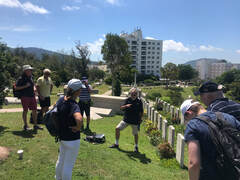
Branch Visit to Stanley Military Cemetery 12th July 2020
Although the Covid - 19 virus tried its best to thwart our plans, some 17 members and friends of the Branch braved the scorching Hong Kong summer heat to visit Stanley Military Cemetery on Sunday 12 July, 2020.The main aim of the event was to look in some detail into the lives of 5 very brave men who lie there. These are 4 military officers and 1 Hong Kong Government official who were all executed by the occupying Japanese Army in 1943 and who were all posthumously awarded the George Cross for anti-Japanese activities.As the final resting place of 5 George Cross holders, Stanley Cemetery must be unique.The opportunity was taken to look at the graves of others who were killed either during the 1941 battle or subsequent occupation. These people included military personnel and nursing sisters, and one unfortunate HK Police officer, (a former internee), who died whilst swimming near Stanley after the Japanese surrender.A libation or 2 was enjoyed in Stanley Village by a small group of attendees afterwards - whilst practicing social distancing rules! Many thanks to Martin Heyes for organising and leading the event.
Although the Covid - 19 virus tried its best to thwart our plans, some 17 members and friends of the Branch braved the scorching Hong Kong summer heat to visit Stanley Military Cemetery on Sunday 12 July, 2020.The main aim of the event was to look in some detail into the lives of 5 very brave men who lie there. These are 4 military officers and 1 Hong Kong Government official who were all executed by the occupying Japanese Army in 1943 and who were all posthumously awarded the George Cross for anti-Japanese activities.As the final resting place of 5 George Cross holders, Stanley Cemetery must be unique.The opportunity was taken to look at the graves of others who were killed either during the 1941 battle or subsequent occupation. These people included military personnel and nursing sisters, and one unfortunate HK Police officer, (a former internee), who died whilst swimming near Stanley after the Japanese surrender.A libation or 2 was enjoyed in Stanley Village by a small group of attendees afterwards - whilst practicing social distancing rules! Many thanks to Martin Heyes for organising and leading the event.
Branch Social & AGM 23rd December at Gunners Bar, United Services Recreation Club, Jordan, Kowloon.
A social and AGM was held as above 11 members attended including former Branch President and Society stalwart Angus Stevenson-Hamilton visiting from the U.K. The minutes of the Meeting can be seen here: OMRS AGM 2019 Minutes of Meeting
A social and AGM was held as above 11 members attended including former Branch President and Society stalwart Angus Stevenson-Hamilton visiting from the U.K. The minutes of the Meeting can be seen here: OMRS AGM 2019 Minutes of Meeting
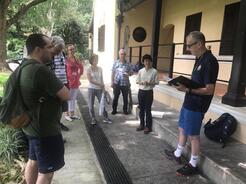
30th June 2019 visit to the Green Hub - a small but enthusiastic group of Branch members and friends braved the heat to visit the old Tai Po Police Station in the New Territories (N.T.), now renamed the Green Hub. The group included Branch stalwart and former Hon. Secretary John Leighton, visiting from the United Kingdom. The police station opened in 1899 shortly after the leasing of the N.T. to the United Kingdom by the Qing Government. It functioned as a police station until 1987. The Hong Kong SAR Government selected the Kadoorie Farm and Botanic Garden to run the project as a Green Hub by transforming the site into a conservation and education centre. The group was guided around the complex by an excellent docent from the Green Hub, Ms. Chong, and heard some interesting stories of the days when it served as a police station. The story of Chief Inspector William McHardy, BEM, CPM and his wife Mona, whose career was inextricably linked with the building, was recounted, as was the discovery of a large quantity of ammunition in the station garden in the mid-1980’s, believed to have been buried there ahead of the Japanese invasion in 1941. The visit concluded with a lively discussion and refreshments in the former Police canteen.
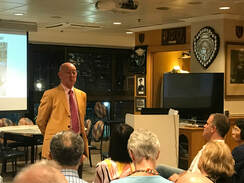
30th April 2019 a talk by Lt. Col. Nigel Collett on the The Jallianwala Bagh Massacre, also known as the Amritsar Massacre - the Branch held a well-attended presentation almost to the day of the 100th anniversary of one of the most momentous occasions in Anglo-Indian history; the massacre in the Jallianwala Bagh at Amritsar in the Punjab of many hundreds of Indian citizens under the direction of Indian Army officer General Reginald Dyer. Approximately 30 members and friends of the Branch heard a presentation given by retired Lt. Col. Nigel Collett at the Royal Hong Kong Regiment (V) Association clubhouse. Nigel Collett, a Branch member, was originally commissioned into the Devon and Dorset Regiment with whom he served in Northern Ireland. After service with the Sultan of Oman’s Armed Forces he transferred to the Gurkha Rifles, rising to the rank of Lt.Col. and commanding the 1st Bn. 6th Queen Elizabeth’s Own Gurkhas. Nigel read history at Oxford University and is the author of the critically acclaimed book “The Butcher of Amritsar – General Reginald Dyer,” (2005).
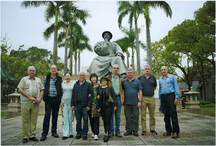
13th & 14th March 2019 Visit to the Bogue Forts and other locations related to the China Wars - An overnight visit to the Bogue Forts and other sites of interest in the Pearl River Delta was held in March. Ten members and friends attended and visited Humen Sea Power Museum and the Weiyuan and Nanshan Forts on day one. On day two we visited the site of the June 1839 destruction of the British traders' opium ("the opium pits") by Imperial Commissioner LIN Zexu which led to the First Opium War and in the afternoon the site of the former Whampoa Military Academy in Guangzhou. With thanks to our able in-house tour guide - Martin Heyes. Read Martin's report on the visit HERE.
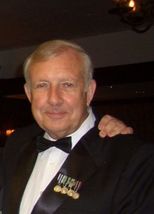
Talk by Angus Stevenson-Hamilton, QPM, CPM on the Chinese Regiment - 24th January 2019 Past President Angus Stevenson-Hamilton gave a fascinating talk on The Chinese Regiment 1899 -1906, the only one in the British Army. Raised initially to police the Wei Hai Wei concession and British naval anchorage. Subsequently caught up in the Boxer rebellion, Third China War. They acquitted themselves well but were not treated very kindly by the British. Disbanded when no further use could be found for them. Remnants went on to in the First World War, Chinese Maritime Customs and Shanghai. Angus is a former President of the Hong Kong Branch and Assistant Commissioner of Police, Royal Hong Kong Police with an extensive knowledge of the China wars.
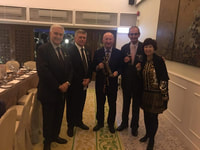
Branch Christmas Dinner - On Friday 7 December 2018, a little over 20 members, guests and friends of the Branch enjoyed an excellent Christmas Dinner at the United Services Recreation Club, Jordan, Kowloon. A sumptuous repast was provided and, as always, the lucky draw proved to be a popular attraction. Our thanks to Mike Broom for facilitating this wonderful venue and Martin Heyes for running the lucky draw.

'Bewitched, bothered and bewildered; a career beguiled by Gurkhas and Nepal' - The Branch organized a very well-attended talk held at the Royal Hong Kong Regiment (the Volunteers) Clubhouse on the evening of Thursday 25 October 2018.
Over 30 Branch members and guests attended a very interesting presentation given by retired Lieut. Colonel Nigel Collett on his experiences serving with the Regiment into which he was commissioned, (1st. Bn. Devon and Dorsets); the Sultan of Oman’s Armed Forces and finally, 1st. Bn. 6th Queen Elizabeth’s Own Gurkha Rifles.Nigel supplemented his talk with a power point presentation, and a lively question and answer session followed. Great use was made of the cash bar provided by the Volunteers Association, and the Branch thanks the latter for very generously allowing us the use of their wonderful facility located in the Happy Valley Racecourse.
Over 30 Branch members and guests attended a very interesting presentation given by retired Lieut. Colonel Nigel Collett on his experiences serving with the Regiment into which he was commissioned, (1st. Bn. Devon and Dorsets); the Sultan of Oman’s Armed Forces and finally, 1st. Bn. 6th Queen Elizabeth’s Own Gurkha Rifles.Nigel supplemented his talk with a power point presentation, and a lively question and answer session followed. Great use was made of the cash bar provided by the Volunteers Association, and the Branch thanks the latter for very generously allowing us the use of their wonderful facility located in the Happy Valley Racecourse.
Medals of Lt. Col. Reginald Walker, OBE, MC, ED - On Saturday 18th August at the Museum of Coastal Defence, Shau Kei Wan, Dr. KWONG Chi Man, Assistant Professor in the History Department of the HK Baptist University, spoke on the medals awarded to Lt. Col. Reginald Walker, OBE, MC, ED a member of the HK Volunteer Defence Corps who served in the military during both world wars. Lt. Col. Walker was an engineer who served with the Royal Engineers during the Great War. He later became an engineer with the Kowloon Canton Railway; served with the HKVDC during the 1930s and the fall of Hong Kong during which he was wounded and made a POW and subsequently had the honour of having a post-war KCR diesel locomotive named after him! His medals are owned by the Museum of Coastal Defence; hence the selection of that venue the event. Our thanks to the museum and Dr Kwong.
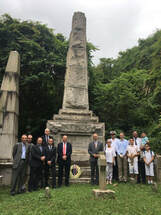
La Fronde Memorial Ceremony
La Fronde was a French torpedo destroyer which was sunk in Hong Kong during “the great typhoon” of 1906, resulting in the death of 5 sailors. Following this tragedy a memorial was erected to the incident, which now stands in the HK Cemetery in Happy Valley. Over the years the monument had deteriorated quite alarmingly, but thanks to the efforts of a number of people has now been restored. A re dedication ceremony was held at 11:00 hrs in the Cemetery on Thursday 5 July 2018, at which a number of branch members were present, including Paul Harrison who was involved professionally with the restoration work. Background information can be found in an SCMP article linked to here .The event was hosted by the Consul-General of France, M. Eric Berti, and many of the sizeable French community in Hong Kong attended, including M. Xavier Pech, who spoke at the ceremony wearing his uniform as a Lieutenant Commander. Both M. Berti and M. Pech serve in the French Navy Reserve (citizen service), with M. Berti holding the rank of Commander. M. Pech referred to the vessel as a frigate in his short talk at the memorial, whereas other references to the warship refer to it as a “torpedo destroyer” - it is referred to as a destroyer on the monument. M. Berti mentioned that although the monument highlights the part played by the British community in Hong Kong when it was first commissioned, sight must not be lost of the efforts made by the French community; not only in Hong Kong at that time, but also the part played by French citizens of what was then known as French Indo-China, in its construction. And, of course, the role played by the modern French community of HK in terms of fund-raising to have it restored.
La Fronde was a French torpedo destroyer which was sunk in Hong Kong during “the great typhoon” of 1906, resulting in the death of 5 sailors. Following this tragedy a memorial was erected to the incident, which now stands in the HK Cemetery in Happy Valley. Over the years the monument had deteriorated quite alarmingly, but thanks to the efforts of a number of people has now been restored. A re dedication ceremony was held at 11:00 hrs in the Cemetery on Thursday 5 July 2018, at which a number of branch members were present, including Paul Harrison who was involved professionally with the restoration work. Background information can be found in an SCMP article linked to here .The event was hosted by the Consul-General of France, M. Eric Berti, and many of the sizeable French community in Hong Kong attended, including M. Xavier Pech, who spoke at the ceremony wearing his uniform as a Lieutenant Commander. Both M. Berti and M. Pech serve in the French Navy Reserve (citizen service), with M. Berti holding the rank of Commander. M. Pech referred to the vessel as a frigate in his short talk at the memorial, whereas other references to the warship refer to it as a “torpedo destroyer” - it is referred to as a destroyer on the monument. M. Berti mentioned that although the monument highlights the part played by the British community in Hong Kong when it was first commissioned, sight must not be lost of the efforts made by the French community; not only in Hong Kong at that time, but also the part played by French citizens of what was then known as French Indo-China, in its construction. And, of course, the role played by the modern French community of HK in terms of fund-raising to have it restored.
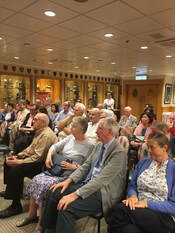
Talk By Tony Banham on his book "Reduced to a Symbolic Scale"
On Saturday 28 April the Branch hosted a talk by local historian and author, Tony Banham, on his latest (and perhaps NOT now final) book, entitled “Reduced to a Symbolical Scale.” The book details the evacuation of thousands of British subjects from the former Crown Colony of Hong Kong, to Australia, in the face of Japanese aggrandisement ahead of the Pacific War in 1941. The talk was held in the Royal Hong Kong Regiment Volunteers Association Clubhouse in t Happy Valley Racecourse. It was apparent, from the interest shown by many attendees in the many artefacts held by the Association on display, that this was the first time that many people had visited this venue. Our thanks to the Royal Hong Kong Regiment (the Volunteers) Association for kindly allowing us the use of the Clubhouse. The provision of a cash bar also proved to be a popular decision! The event was a great success with over 40 people present. Attendees included not only Branch members, but also many people with a general interest in this turbulent but fascinating period in Hong Kong’s history.
On Saturday 28 April the Branch hosted a talk by local historian and author, Tony Banham, on his latest (and perhaps NOT now final) book, entitled “Reduced to a Symbolical Scale.” The book details the evacuation of thousands of British subjects from the former Crown Colony of Hong Kong, to Australia, in the face of Japanese aggrandisement ahead of the Pacific War in 1941. The talk was held in the Royal Hong Kong Regiment Volunteers Association Clubhouse in t Happy Valley Racecourse. It was apparent, from the interest shown by many attendees in the many artefacts held by the Association on display, that this was the first time that many people had visited this venue. Our thanks to the Royal Hong Kong Regiment (the Volunteers) Association for kindly allowing us the use of the Clubhouse. The provision of a cash bar also proved to be a popular decision! The event was a great success with over 40 people present. Attendees included not only Branch members, but also many people with a general interest in this turbulent but fascinating period in Hong Kong’s history.
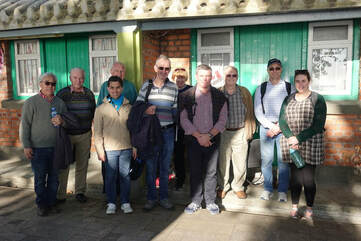
Stanley Visit with Past President David Mahoney.
The Branch organised a wartime walking tour of Stanley on 14th January 2018 to mark the visit to Hong Hong of David Mahoney, a branch founder member and Past President. On a perfect Hong Kong winter’s day our own Martin Heyes led the way taking us to St Stephens College (where many wounded soldiers and nurses were massacred on Christmas Day 1941), Stanley Prison (the wartime civilian internment camp) and Stanley Military Cemetery. As we moved through the cemetery members were able to relate accounts of individuals resting there as well as accounts of the fighting at Stanley which was the final stand of the British garrison in December 1941.The day concluded suitably with a few ales at almost historic Smugglers Inn – a regular haunt of the British Stanley garrison before the change of sovereignty. Needless to say, a certain amount of medal bartering was conducted over the ales.
The Branch organised a wartime walking tour of Stanley on 14th January 2018 to mark the visit to Hong Hong of David Mahoney, a branch founder member and Past President. On a perfect Hong Kong winter’s day our own Martin Heyes led the way taking us to St Stephens College (where many wounded soldiers and nurses were massacred on Christmas Day 1941), Stanley Prison (the wartime civilian internment camp) and Stanley Military Cemetery. As we moved through the cemetery members were able to relate accounts of individuals resting there as well as accounts of the fighting at Stanley which was the final stand of the British garrison in December 1941.The day concluded suitably with a few ales at almost historic Smugglers Inn – a regular haunt of the British Stanley garrison before the change of sovereignty. Needless to say, a certain amount of medal bartering was conducted over the ales.
